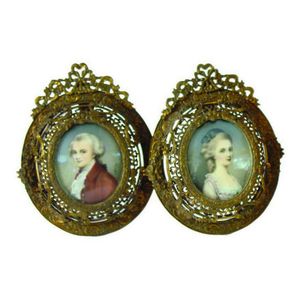Antique Pietra Dura Floral Cuff Links
You must be a subscriber, and be logged in to view price and dealer details.
Subscribe Now to view actual auction price for this item
When you subscribe, you have the option of setting the currency in which to display prices to $Au, $US, $NZ or Stg.
- Cannetille Work - Cannetille work is a type of jewellery-making technique that involves the use of fine wire, typically made of gold or silver, to create intricate and delicate designs. The wire is shaped and twisted into various forms, such as leaves, flowers, and scrolls, and then applied to the surface of the jewellery piece. The wire is then soldered to the piece, and the excess wire is often removed to create a smooth surface.The technique originated in the 18th century in France and Italy, and was particularly popular during the Victorian era. It was often used to decorate brooches, bracelets, and necklaces, and was a highly skilled and labour intensive technique. Cannetille jewellery is known for its intricate and delicate appearance and is highly valued by collectors.
- Pietra Dura / Florentine Mosaic - Pietre dura, also known in English as "Florentine mosaic" is a decorative art that originated in Renaissance Italy and involves the creation of intricate, multi-layered inlaid designs using a variety of different coloured stones. The name "pietre dura" is Italian for "hard stones," and refers to the use of hard, durable materials such as marble, agate, jasper, and other semiprecious stones in the creation of the designs.
The origin of pietre dura can be traced back to ancient Rome, where the technique was used to create intricate inlaid designs for mosaic floors, walls, and other architectural elements. During the Renaissance, the technique was revitalized in Italy and became particularly associated with the city of Florence. The court of the Grand Duke of Tuscany, Cosimo I de' Medici, was a major patron of pietre dura and employed many of the leading artists and craftsmen of the time to create a wide range of objects, from small items like jewelry boxes and vases to large panels and furniture.
In the 19th century, pietre dura was used to create a wide range of decorative objects, from furniture and decorative panels to small items like jewelry boxes, vases, and picture frames. During this time, the technique was particularly popular in Europe, where it was used to create elaborate pieces of furniture and other decorative objects for the wealthy and aristocratic classes.
In addition to traditional pietre dura objects like cabinets, tables, and vases, the 19th century saw the development of new forms of pietre dura, such as book covers, cigar boxes, and other small items. This was largely due to the advent of new, more affordable production techniques and materials, which allowed for the creation of pietre dura objects on a larger scale and at a lower cost.
This item has been included into following indexes:
Visually similar items

Two 18th century portrait miniatures, of a gentleman in black coat, white waistcoat and chemise, the other a lady in blue dress (2)

A pair of early/mid 20th century portrait miniatures in gilt glass frames of Mozart and his companion, in formal dress, signed Cosway

Miniature portrait: painted on ivory of Marie Antoinette housed in ornate brass oval frame. 14 cm x 11 cm overall

An exceptional 18ct. gold sapphire and diamond dress ring, the 6.70ct. mixed cushion cut cornflower blue sapphire claw set and surrounded by 16 round brilliant cut diamonds. TDW 1.00ct
